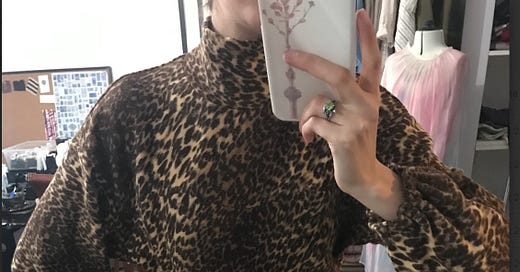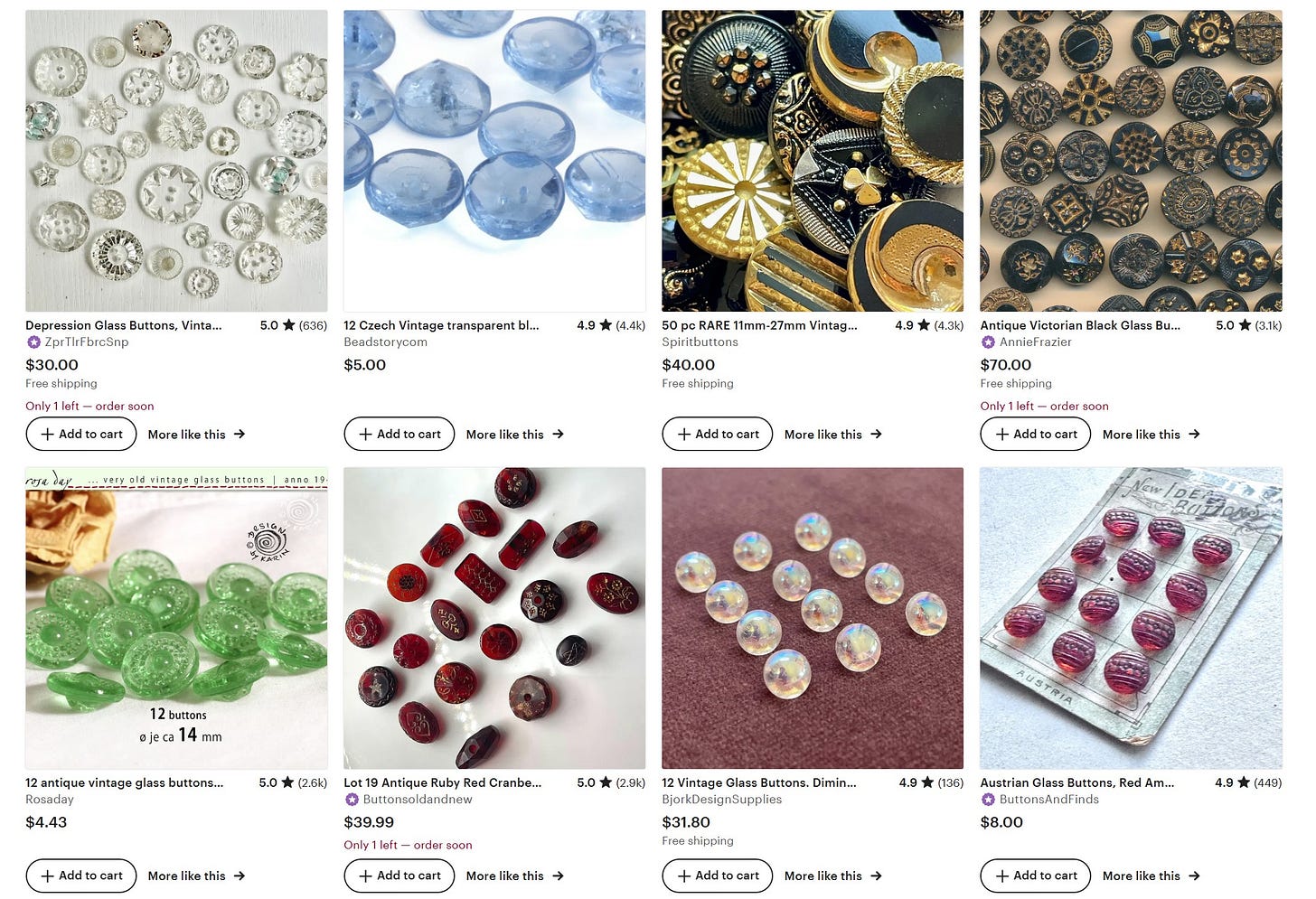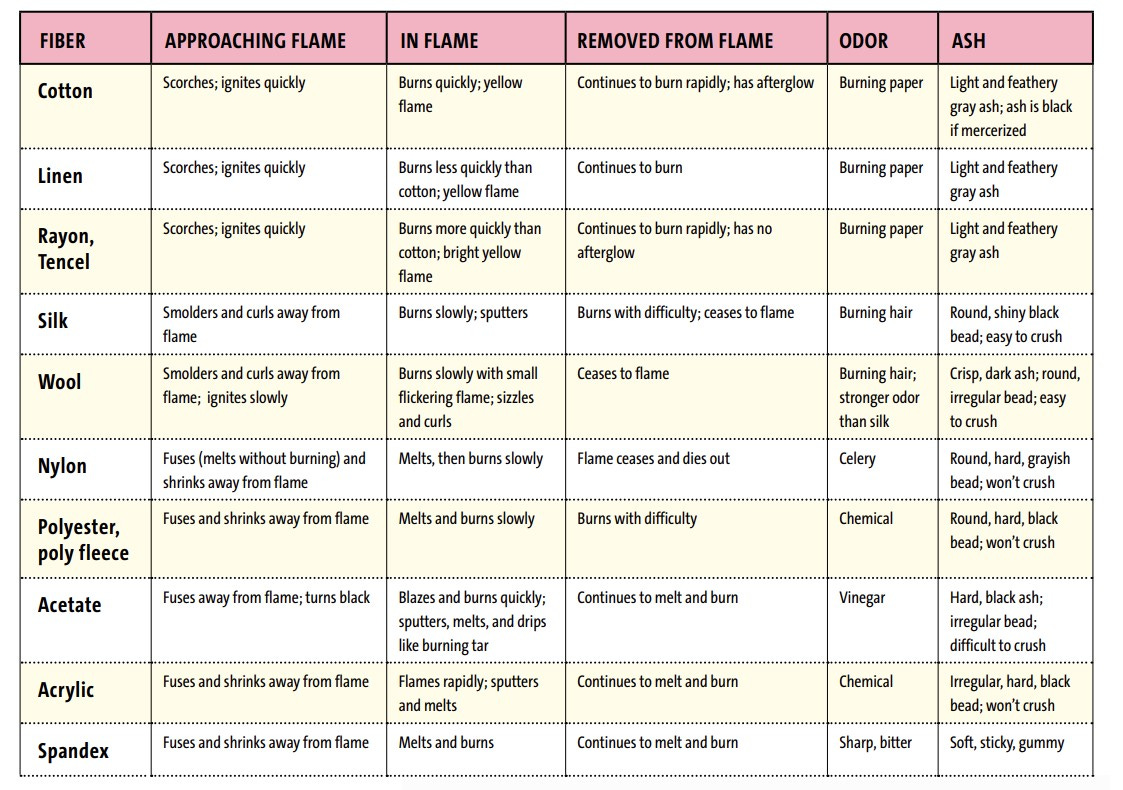It makes sense that sewists tend to also be thrifters. Both practices value thoughtfulness and effort. The more you learn about how clothes are made, the better you are at assessing quality and fit. And the more you make your own clothes, the more you realize you can wear whatever you want and you don’t need to participate in the trend cycle. I’m sure there are plenty of us with a bit of a hang-up on being unique, too. Whether you thrifted your fit or made it (or a combination of both), no need to worry if anyone else will be wearing the same thing.
My background in thrifting
I grew up thrifting and ended up working in the consignment industry for several years, mostly sorting and pricing items. I handled and assessed thousands and thousands of items and, despite not always loving the customer service aspect, it was fun and fascinating. I learned so much about clothing construction, retail and design history, as well as observing the psychology of consumerism. I started tweaking my thrifted items more to my liking, mostly through dyeing and painting, which ultimately lead to me making my own clothes.
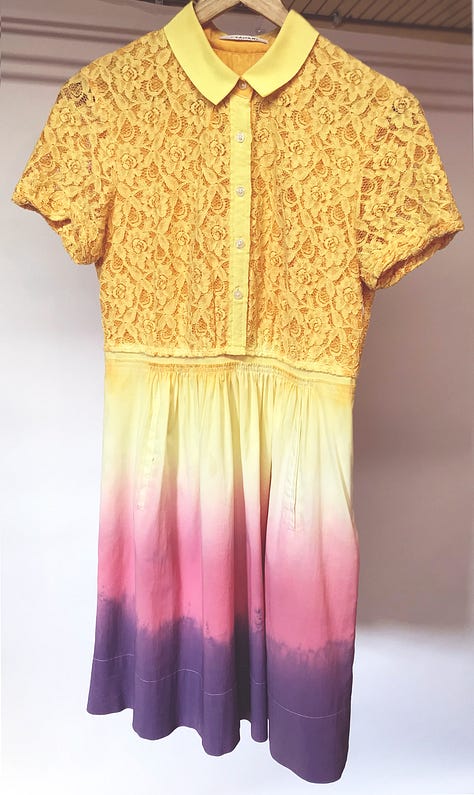
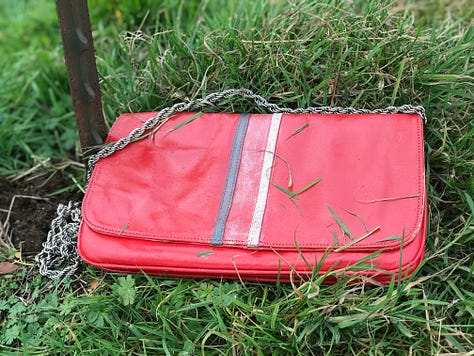
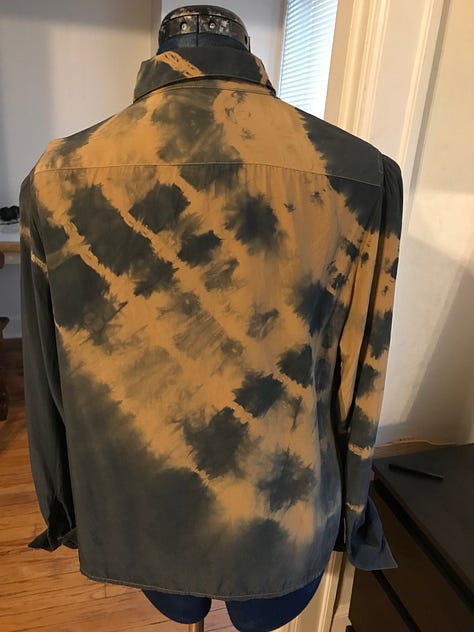
But first, I had to overcome a bit of an addiction. For several years after leaving the industry, secondhand shopping remained one of my chief hobbies. Though it was enjoyable and I found so much great stuff, eventually I realized I was collecting things for the sake of collecting. It was overconsumption in the form of ‘ethical’ shopping. This phenomenon can be hard to avoid as a thrift (or consignment or vintage) shopper. When you find something great for a steal, it does give you a brain chemical boost and sense of accomplishment. I’ve even drawn things I really wanted in my sketchbook and later found that exact thing at the thrift, which felt pretty magical.
The fact that you can always go into your closet and donate or sell something to make room also helped me justify more purchases. While I still try to roughly follow a ‘one in, one out’ rule, eventually I had to honestly ask myself, why do I constantly need to cycle things in and out? Just for the sake of change? Do I even really want to be changing my style this often?
I’ve managed to learn to be happier with what I have, and to replace a lot of my thrifting time with other hobbies, including sewing. Part of how I’ve been able to move away from over-thrifting is that the market isn’t what it used to be, and I’m clearly not the only one who has noticed (see the video above). The influx of ultra-fast fashion and growth of online resale have made a huge impact on both selection and price in the last few years. It is kind of wild to think how much stigma there was around thrifting when I was growing up, and now it is so much more acceptable, yet the quality of the experience has gone down. I guess that’s the path of something becoming popular! Cue the millennial ‘hipster’ gripe, “I liked it before it was cool…”
The fabric and notion exception
The good news is, at least from what I’ve seen, fabric and other sewing-related items aren’t in demand enough to have been impacted by these issues in the same way as apparel. When you think about it, the reasons people donate sewing supplies is usually a bit different than for things like clothes and homewares. They can be leftover from something someone already made, or there because someone fell out of love with sewing, or they bought too much and their tastes changed, or they inherited a stash from someone, or found one in the attic, etc... It takes work to turn supplies into something useable and if you don’t have the time or skills, it can easily end up being donated (much to our delight).
Thrift, vintage and antique stores, along with yard and estate sales, are excellent places to stock up your notion stash. Aside from elastic and thread, which dry out over time, and perhaps the occasional rusty metal zipper, notions don’t ‘go bad.’ And you can get hard-to-find materials like glass and shell buttons cheaply. There is an antique store near me that sells delightful buttons and buckles from the 1930s and 40s, the quality is amazing and they can add such a special touch to a project.
When it comes to fabric, the two types I buy almost exclusively secondhand are sampling fabrics, linings and interlinings. These should be pretty easy to find as you don’t necessarily have to like how they look. Even if you use old sheets, there’s no reason to buy new muslin! Try bringing swatches or pictures on your phone of your current fabrics when you go shopping, that can help you choose something similar enough to make an effective toile, or that will pair well as a lining.
What to think about when shopping for fashion fabric
Aside from the inherent randomness of the selection, perhaps one of the biggest issues you might run into with secondhand fabrics are that the pieces tend to be small. I will definitely have some suggestions for projects for small pieces in a future post, but there is a lot one can do. Aside from small or highly-pieced clothing items, there are accessories, bags, gifts for kids, and definitely don’t be afraid of mixing fabrications! A contrasting placket or collar, the inside of a cuff, or somewhere else more unexpected can add such a unique ‘designer’ touch to a garment.

Another big one is the odor issue. Since a lot of donated fabrics have been sitting around for a while, they can acquire a certain level of mustiness. This is why I tend to seek out natural fibers as much as possible, they are generally easier to deodorize than synthetics, especially polyester. I don’t use a lot of scented laundry products, but I’ve found that adding a teeny bit of Synthrapol, a heavy duty detergent used by dyers, to your regular soap can be a big help. The biggest enemy of a musty smell is sunlight, so if you live in a warmer/drier climate, definitely dry your piece outside. If not, try drying it in front of a window.
All of that said, here is my number one tip: Be sure to take your time with a potential piece before purchasing. Drape it over your body, wrap it around your arm, rub it hard with your fingers, crumple it, look through it to see if any air flows through, see how it moves. I promise you won’t look crazy, just like a very serious designer! I’ve seen designers do this exact thing when buying couture fabrics in Paris. Especially since you don’t have the same information that you would at a fabric store, you need to collect it yourself in a more intuitive way. This is another good reason to bring some swatches of your current fabrics, if even just for a frame of reference.
Once you commit to a piece, you can burn test it to learn even more.
The burn test
No, it’s not the next evolution of the the ‘Burn Book’ from Mean Girls, the burn test is a way you can see what a mystery fabric is by burning a little piece of it and observing the results. A quick search will bring up a ton of similar free guides to burn testing. Personally I like this one from Threads Magazine; I have it printed out and handy in my studio.
You can certainly understand how to use something without knowing exactly what it is made out of, and it is kind of up for debate how much it really matters what the fiber content of your fabric is. Personally, I think it’s still valuable. My biggest reasons for wanting to know: breathability factor (synthetics tend not to breathe well so I will avoid them for anything fitted under the arms) and knowing how best to care for it.
Natural and synthetics alike can have laundering quirks that you will want to be aware of. And, as I mentioned, odors can be an issue and you want to be able to wash it in the harshest conditions as possible. It an also be part of your general education about fabrics, which as I mentioned in my previous post, is a vitally important part of learning how to sew!
Using home decor fabrics
Judging by the number of viral videos there are on the topic, there are a lot of folks that like using thrifted curtains or other home decor fabrics to make clothes. The good news is there isn’t necessarily a huge difference between many home decor and apparel fabrics. The bad news is that fabrics that are designed to hang from a rod rather than move with a human body might fall kind of awkwardly, not breathe, or just be generally uncomfortable to wear. The interesting thing is that many older curtains you would find at the thrift are homemade and may have been made out of apparel fabric anyway.
Just make sure you like how it looks on your body, not just stretched out in front of you. If you have a shopping companion, have them take a picture. Personally, I haven’t had great results making clothes out of home fabrics, except for something really structured like a corset top. I prefer them for other home projects or accessories, especially hats and bags.
Just for fun: two of my favorite thrifted fabric projects

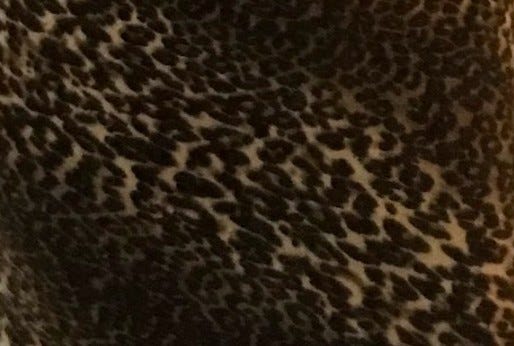
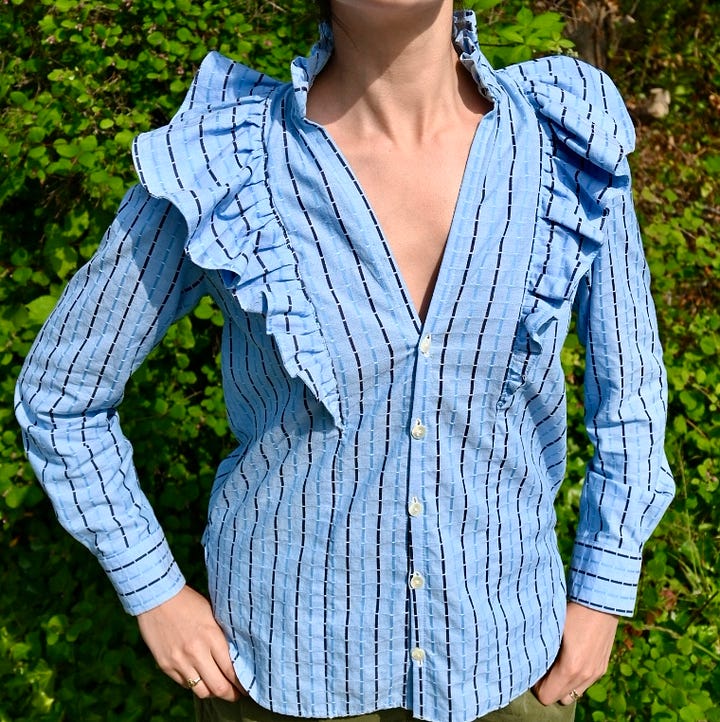
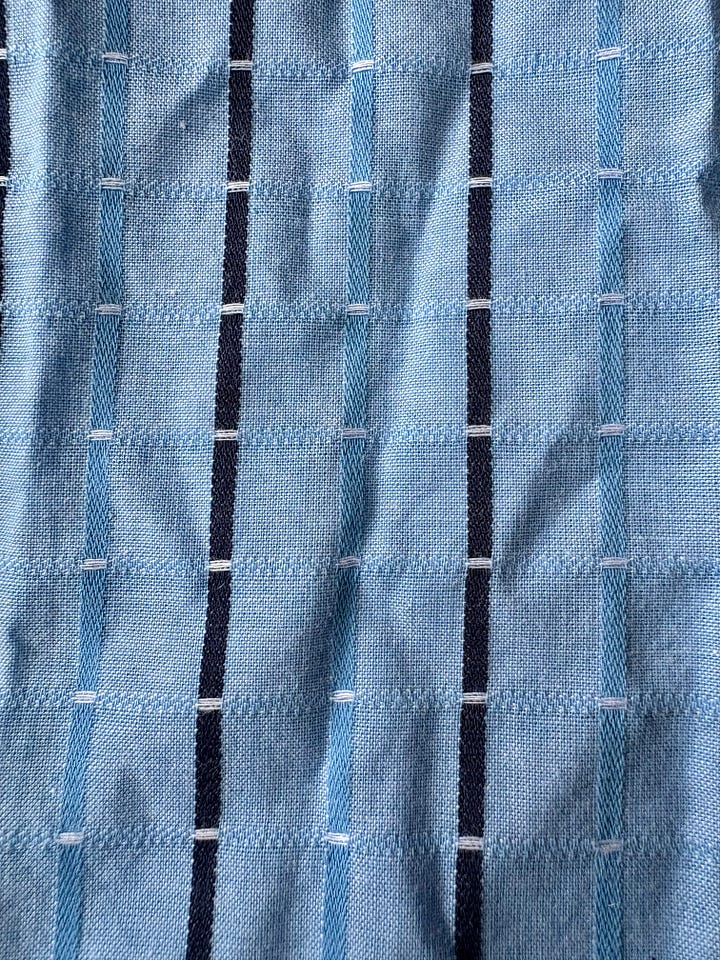
The knit dress on top was made from a wool/poly blend leopard print I scored at Goodwill, and the quality of the print is so good! I love the diagonal movement it has. I shared the blouse below previously; I purchased this cotton shirting at a creative reuse shop and absolutely love the texture.
What do you think, do you like secondhand shopping or do you find it frustrating? Have you noticed how the market has changed? Do you have any favorite fabrics you thrifted? Please share below! À bientôt, mes amis!
